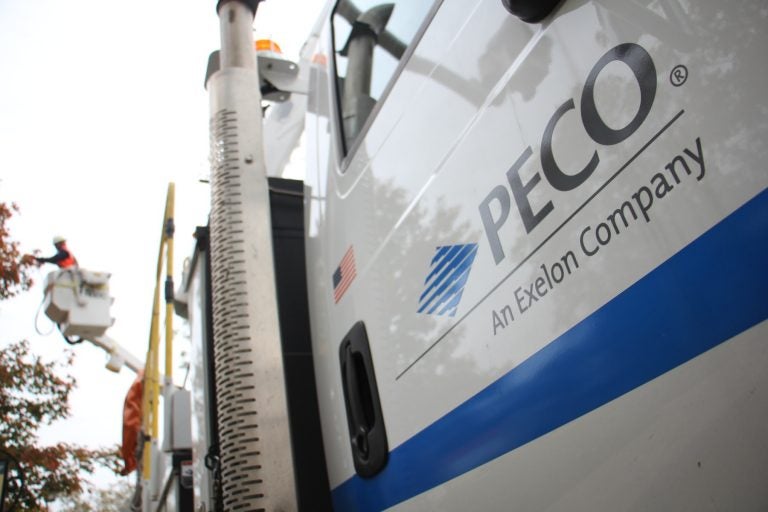PECO to purchase energy from what will be the largest utility-based solar procurement in Pa.
The project will be just 1% of PECO’s total energy mix, enough to provide electricity to 3,000 homes. But climate activists see it as a win and good first step.
Listen 1:36
PECO truck in the foreground, PECO worker in the background (Emma Lee/WHYY)
This story is part of the WHYY News Climate Desk, bringing you news and solutions for our changing region.
From the Poconos to the Jersey Shore to the mouth of the Delaware Bay, what do you want to know about climate change? What would you like us to cover? Get in touch.
PECO has agreed to add 25 megawatts of solar energy to its mix of sources that generate electricity for customers in southeast Pennsylvania, which is enough to power 3,000 homes. The plan would create the largest solar procurement by a utility in Pennsylvania serving “default” customers, or those who do not opt to buy from a third-party provider.
“What’s exciting is that this is a really important first step, something that PECO has never done,” said Wendy Greenspan, a volunteer with the climate justice group POWER Interfaith. “It’s good for our wallets and it’s good for the planet.”
Climate activists like Greenspan have been pushing PECO to increase its use of renewables within its energy mix. The agreement is part of a deal hammered out with a coalition of groups collectively known as the Energy Justice Advocates, which intervened in a case before the Pennsylvania Public Utility Commission.
PECO is required every four years to submit its power purchasing plan to the PUC. Known as the default service program, it details the utility’s procurement, implementation and contingency plans for generating electricity for its customers over a four-year period. About 77% of ratepayers in PECO’s service area opt for “default” service as opposed to signing up with an alternative provider.
PECO’s petition for approval of its default service program before the PUC is essentially the only opportunity for the public to weigh in on the amount of renewables the utility uses as part of its mix.
The utility’s original proposal submitted earlier this year planned to double the amount of solar energy credits bought through long-term contracts. But that didn’t change the percentage of solar energy within its mix, which remained at 0.5%, the minimum required by the state’s Alternative Energy Portfolio Standards.
The Energy Justice Advocates, which in addition to POWER Interfaith includes the Clean Air Council, PennEnvironment, the Sierra Club, Physicians for Social Responsibility Pennsylvania and Vote Solar, wanted PECO to do more than just purchase credits and intervened in the case. The groups’ expert testimony argued that had PECO done more than simply purchase credits in the past, it could have saved between $67 and $89 million for customers during the current default service program, which expires at the end of May 2025.
The Energy Justice Advocates also emphasized the decreasing costs of wind and solar technologies, which are making these sources increasingly competitive with fossil fuels. So by including wind and solar in the mix of sources, which are primarily nuclear and natural gas, the group said ratepayer costs would be lowered.
PECO spokesman Brian Ahrens said the utility listened to the testimony of all the intervenors before adjusting the plan and resubmitting it to the PUC, which approved the plan Thursday.
“This new program is our way of working to ensure that we’re purchasing energy at the least cost possible over time,” Ahrens said.
Ahrens said 25 MW of solar keeps the renewable input at about 1% of the utility’s total energy mix.
“We considered the risks and determined that a project of this size would not have an adverse impact on our customers,” Ahrens said.
The default service plan approved by the PUC last week, which runs from June 1, 2025 to May 31, 2029, also adds a new item to the bills of those who opt out of the default program.
Customers who purchase electricity through a third party will have a “price-to-compare” calculation on their bills, meaning they will be able to compare what they are paying to what they would pay if they had remained a PECO customer. Typically, PECO customers pay less.
“We were pleased that the PUC has approved our latest [default service plan], which primarily outlines how we’re purchasing electricity for our nonshopping customers for the next four years,” said Ahrens.
The new plan also makes it easier for those who are low-income to switch back to the default plan with PECO, which is the only way for them to take advantage of the utility’s Customer Assistance Program. Currently, customers often have to pay early termination fees to their third-party suppliers, but the new plan would prohibit suppliers from charging those fees to low-income customers seeking to take advantage of the program.
PECO does not produce the energy it provides, but purchases it from suppliers. The agreement to purchase 25 MW of solar energy means that the utility will need to put out a request for proposal, or RFP, to solicit a solar developer in Pennsylvania.
“This is locally produced solar,” he said. “We’re not buying it from Arizona.”
Public comment will be allowed on the utility’s subsequent power purchase agreement, another first for the state.
What makes this agreement unique is that PECO will pay the solar provider for the electricity as well as for providing the capacity — meaning the provider gets paid to guarantee 25 MW of solar will be available to PECO.
The Energy Justice Advocates say this sends “a stronger long-term price signal, directing investment to solar development in the state.”
The plan will move forward despite President-elect Donald Trump’s stated plans to gut clean energy investments at the federal level.
“This win shows that states can continue to take action on climate and advance clean energy even if the federal government doesn’t,” said Devin McDougall, an attorney with Earthjustice who represents the Energy Justice Advocates.

Get daily updates from WHYY News!
WHYY is your source for fact-based, in-depth journalism and information. As a nonprofit organization, we rely on financial support from readers like you. Please give today.







